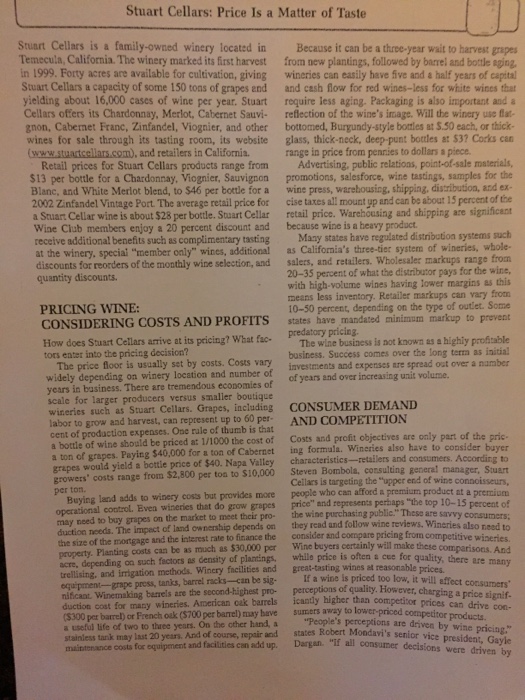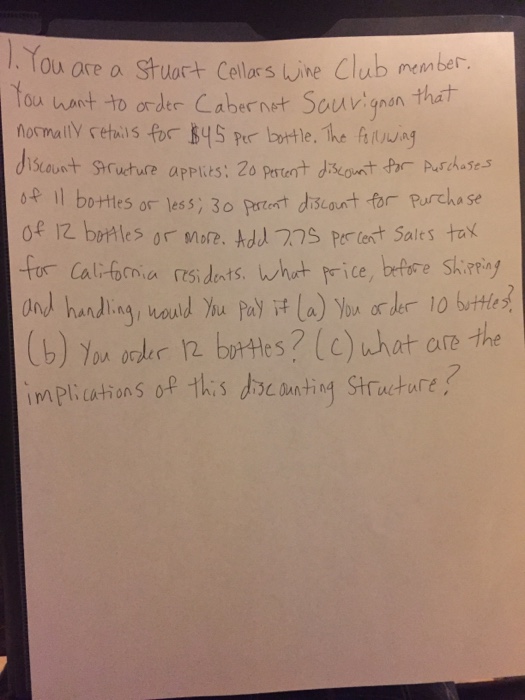Stuart Cellars: Price Is a Matter of Taste Stuart Cellars is a family-owned winery located in Temecula, California. The winery marked its first harvest from new plantings, followed by barrel and bottle Because it can be a three-year wait to harvest grapes in 1999. Forty acres are available for cultivation, giving wineries can easily have ive anda half years of capital Stuart Cellars a capacity of some 150 tons of grapes end and cash flow for red wines-less for white wines that yielding about 16,000 cases of wine per year. Stuart require less aging. Packaging is also important and a Cellars offers its Chardonnay, Merlot, Cabernet Sauvi- reflection of the wine's image. Will the winery use fla- gnon, Cabernet Franc, Zinfandel, Viognier, and other bottomed, Burgundy-style bottles at $.50 each, or thick wines for sale through its tasting room, its website (www.stuartcellars.com), and retailers in California. glass, thick-neck, deep-punt bottles at $37 Corks can range in price from pennies to dollars a piece Retail prices for Stuart Cellars produets range from Advertising, public relations, point-of-sale materials, $13 per bottle for a Chardonnay. Viognier, Sauvignon promotions, salesforce, wine tastings, samples for the Blanc, and White Merlot blend, to $46 per bottle for a wine press, warehousing, shipping, distribution, and ex 2002 Zinfandel Vintage Port. The average retail price for cise taxes all mount yp and can be about 15 percent of the a Stuar Cellar wine is about $28 per bottle. Stuart Cellar retail price. Warchousing and shipping ace significant Wine Club members enjoy a 20 percent discount and because wine is a heavy product receive additional benefits such as complimentary tasting Many states have regulated distribatioa systems such at the winery, special "member only" wines, additional as Califomia's three-tier system of wineries, whol salers, and retailers. Wholesaler markups range from 20-35 percent of what the distributor pays for the wine, with high-volume wines having lower margins as this means less inventory. Retailer markups can vary from 10-50 percent, depending on the type of outlet. Some discounts for reorders of the monthly wine selection, and quantity discounts. PRICING WINE CONSIDERING COSTS AND PROFITS minimom markup to prevent states have predatory pricing How does Stuart Cellars arrive at its pricing? What facThe wine business is not known as a highty prof tors enter into the pricing decision? business. Success comes over the long terra as initial widely depending on winery location and number of investments and expenses are spread out over a number years in basiness. There are tremendous economies of scale for larger producers versus smaller boutique wineries such as Stuart Cellars. Grapes, including The price foor is usually set by costs. Costs vary of years and over increasing unit volume. CONSUMER DEMAND labor to grow and harvest, can represent up to 60 per AND COMPETITION cent of production expenses. One rale of thumb is that proft objectives are only part of the pric- a bottle of wine sbould be priced at 1/1000 the cost of grapes would yield a bottle price of $40. Napa Valley per ton. Costs and profit objectives are only part of the a ton of grapes. Paying $40,000 for a ton of Cabernet ing formula. Wineries also growers' costs range from $2,800 per toa to $10,000 Steven Bombola, corsulting have to consider buyer and consumers. According to manager, Stuart Cellars is targeting the "upper end of wine connoisseurs, characteristics-retallers costs but provides more people who can afford a premium product at a premium wineries that do grow grapes price" and represents perhaps "the top 10-15 percent of market to meet their pro- the wine purchasing public, hese are sarvvy consumers; they read and follow wine reviews. Wineries also need to Buying land adds to winery coss but provides more people who can operational control. Evea wineries that do grow grapes may need to buy grapes on the duction needs. The impect of land ownership the size of the mortgage and the interest rate to finance the consider and compare The impect of land ownership depends on consider and comvai wil make these comparisons. And y. Planting costs can be as much as $30,000 per fncilities and ding on such factors as density of plantings while price is often a cue for quality, there are acre, depen trellising, and irrigation methods. Winery oquipment-grape press, tanks, barrel racks-can be nificaat Winemaking bezrels are the second-highest pro- perceptions of quality, However, charings and great-tastiog is priced too low, it will effect consamers great-tasting wines at reasonable prices. If a wine is priced too low, it will effect consumers than competitor prices can drive co- "People's perceptions are driven by wine pricing" d up. Dargan. "If all consumer decisions were driven by duction cost for many wineries. American cak barrels icantly higher ($300 per barrel) or French oak ($700 per barrel) may have a useful life of two to tree years. On the other hand, a"Peoples stainless tank may last 20 years. And of course, maintonance costs for equipment and facilities can add up sumers away to lower-priced competitor pdut And of course, repair and states Robert Mondavi's senior vice









